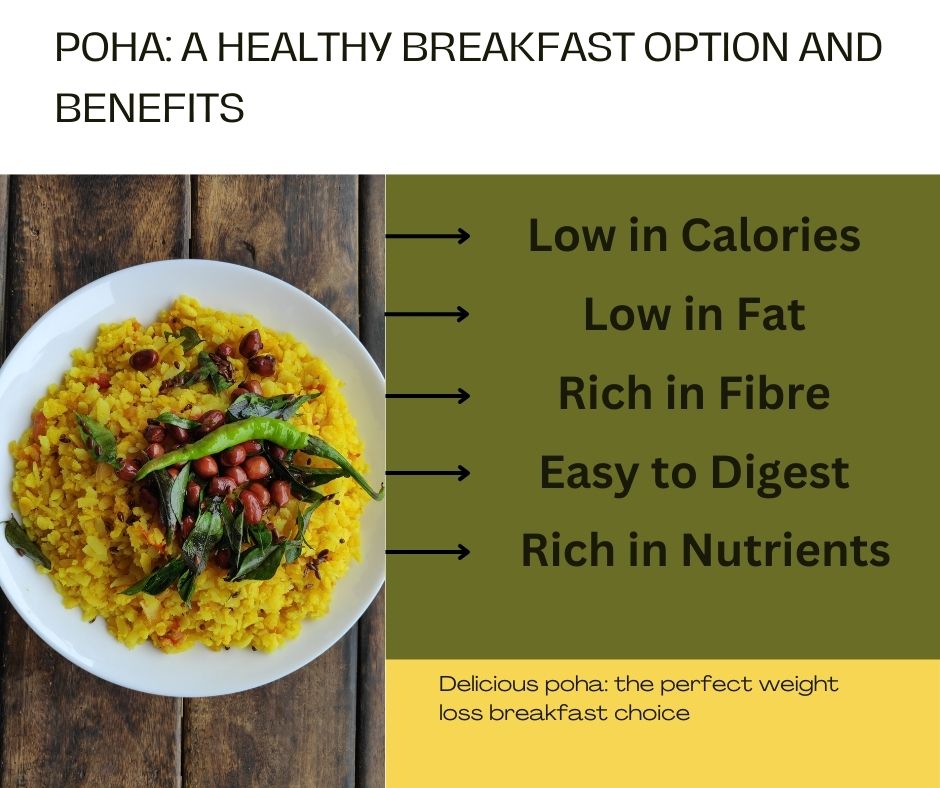
Poha for Weight Loss: What is Poha and How It Supports Your Health Goals
Table of Contents
POHA FOR WEIGHT LOSS: Poha, also known as “flattened rice,” is a very popular breakfast option in Indian households. It is a dish made from rice cooked with little to negligible oil to produce soft rice flakes. The rice flakes are cooked with all the Indian spices and topped with peanuts and cashews. The poha is generally sautéed with mustard seeds, chopped onions, chopped tomatoes, and other spices like cumin and turmeric.
Although one can add any and every ingredient one wants, potatoes and grated coconuts are some of the additional ingredients that can be added.
IS POHA GOOD FOR WEIGHT LOSS?

- Low in Calories: Poha is comparatively low in calories, making it a great option for breakfast. Around 100g of poha has 130-135 calories.
- Low in Fat: Poha is extremely low in fat, making it a wonderful breakfast option for those who are aiming for weight loss. It is also a healthy alternative to other high-fat and high-calorie breakfast options like puri and kachoris, which are frequent in every Indian household.
- Rich in Fibre: Poha contains a substantial amount of dietary fibre, which helps maintain proper health. It keeps one full for longer durations, thus negating the possibility of overeating.
- Easy to Digest: Poha is nothing but flattened rice; thus, it is very easy to digest and is assimilated into the body.
- Rich in Nutrients: Poha is filled with essential nutrients such as iron, vitamins, and antioxidants. It is often topped with nuts and seeds, thus adding the required amount of healthy fats to one’s diet.
NUTRITIONAL VALUE OF POHA
| NUTRIENT | AMOUNT |
| Carbohydrates | 27g |
| Protein | 3g |
| Fat | 0.3-1g |
| Fibre | 1-2g |
| Iron | 2.5mg |
| Calcium | 5-10mg |
| Sodium | 5-6mg |
| Calories | 130-150kcal |
POHA RECIPE FOR WEIGHT LOSS
Ingredients for Poha to lose weight are:
- ½ a cup poha
- One tablespoon of oil or butter
- One teaspoon cumin seeds
- One tablespoon of mustard seeds
- Curry leaves
- Chopped onions, tomatoes, bell peppers
- ½ a cup of green peas (pre-boiled)
- One teaspoon turmeric
- Salt for taste
- Lemon zest or teaspoon of lemon juice
- Handful of cashew nuts, peanuts and even crushed almonds
Recipe for making Poha for weight loss
- The poha is first prepared by washing it and then boiling it in hot water on a stove. It is cooked until soft but should not become mushy.
- Then, the vegetables of choice are washed, chopped into fine pieces, and cooked in minimal olive oil. Beans, peas, onions, tomatoes, carrots, and potatoes are lightly sautéed under low flame.
- Then, cumin seeds and curry leaves are added to the pan and made to saute for a few seconds.
- The peanuts and almonds, if added, are roasted until golden brown.
- Then, the boiled poha is added to the pan, along with turmeric powder and salt, as per taste, and mixed properly.
- The poha is properly mixed with the vegetables and spices.
- The poha is cooked for 2-3 minutes under low flame.
- Then, the flame was turned off, and a teaspoon of lemon juice or lemon zest was added.
- The roasted peanuts are added from the top.
- Then, the poha is served hot.
Additional Tips to prepare Poha for Weight loss
Weight loss is based on the concept of a “calorie deficit.” Hence, the calories consumed should be checked. However, it is not necessary to fast or cut down every food item from one’s diet. Poha, being a crowd-favourite breakfast option, is generally considered very healthy.
However, it is also possible to enhance its nutritional quality by adding certain extra vegetables like bell peppers, spinach, and broccoli, which would aid in increasing the fibre content in poha. This makes the poha more filling, thus preventing overeating, an important aspect of weight loss. Less oil should be used, and non-stick utensils can be used to reduce the cooking time. Potatoes are high-calorie vegetables, so it would be wise to limit potatoes from the poha if possible. Lastly, the portion size should be checked if weight loss is desired. The above steps would help in a sustainable way of weight loss.
FAQs Related to Poha for weight loss
Is Poha a better choice of breakfast than other available options for weight loss?
Yes, definitely. Poha is a better breakfast choice than other options like chole bhature, puri-sabji, Maggi, and bread. It is extremely low in calories and thus can be included in one’s daily breakfast schedule for weight loss.
Can I add protein powder to my poha for weight loss?
Yes. One can definitely add protein powder to their poha to make it a more balanced meal. However, it is better to add scrambled eggs and boiled chicken to the poha. That would also act as a good source of protein. A balanced diet is extremely important for gaining or losing weight.
Is store-bought poha effective for weight loss?
Store-bought poha mixes are all over the market nowadays. One can definitely opt for packaged poha mixes, but they might have additional preservatives or salts and refined sugars added to them, which might delay the weight loss journey. Thus, even though it is fine to consume store-bought mixes, making them naturally in the home would be the absolute best.
Can children have poha for weight loss?
Yes, poha is a safe and versatile food option that can be easily given to children and toddlers. It would add nutrition to their diet as well as taste. Even though, for children, weight loss shouldn’t be the primary goal of consuming poha, if needed and desired, the parents can follow the recipes provided by this article by DIET4UWELLNESS and make their kids a healthy breakfast. However, it is best to consult a dietician like Dt. Rukhsana Azhar before giving store-bought poha mixes to their children.

Hello My Name is Dt. Ruksana Azhar and I am a certified dietician and providing online & offline services for Weight Management, PCOS/PCOD Management, Diabetes Management , etc. I have 12+ years of experience in the Apollo Hospital Delhi , Max Super Specialty Hospital Delhi, Lilavati Hospital Mumbai and VLCC healthcare Mumbai. I loves to write healthcare and lifestyle related blog. My favorite part of being a doctor is the opportunity to directly improve the health and wellbeing of my patients and to develop professional and personal relationships with them.



